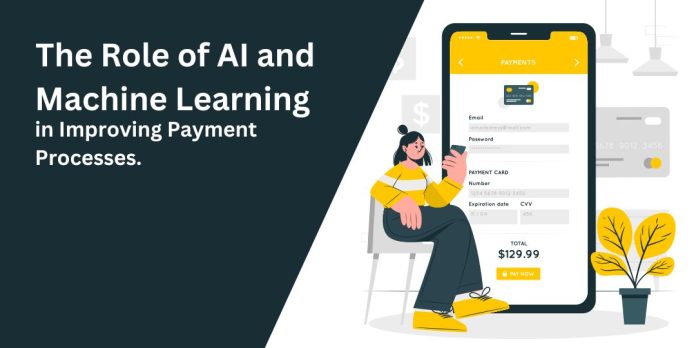Artificial Intelligence (AI) refers to the ability of computers to perform tasks that typically require human intelligence, such as pattern recognition, decision-making, and natural language processing. Machine Learning (ML) is a subset of AI that involves the use of algorithms and statistical models to enable computers to learn from data and make predictions or decisions without being explicitly programmed.
Payment processes are a critical component of commerce, enabling businesses and consumers to exchange goods and services for money. The payment process must be efficient, secure, and user-friendly to ensure the smooth operation of the economy. This is why the integration of AI and ML technologies in payment processes has become increasingly important in recent years.
The integration of AI and Machine Learning technologies has greatly improved payment processes, providing a more efficient, secure, and user-friendly experience for businesses and consumers alike.
In this blog, we will explore how AI and ML technologies have transformed payment processes, and the impact this has had on businesses and consumers.
Advantages of AI and Machine Learning in Payment Processes
Increased Efficiency
Automated processing and reconciliation
One of the key advantages of AI and ML in payment processes is the automation of manual tasks such as payment processing and reconciliation. By automating these processes, the risk of human error is greatly reduced, leading to increased efficiency and accuracy.
For e.g., a payment processing platform that integrates AI and ML technologies can automatically match incoming payments to the corresponding invoices, reducing the time and resources required to manually reconcile payments.
Reduction of manual errors
Manual errors are a common occurrence in payment processes, particularly in manual data entry and reconciliation. These errors can result in delays, decreased accuracy, and even costly penalties for businesses.
However, with the integration of AI based payment technology along with ML technologies, these manual errors can be reduced or even eliminated. For example, an AI- platform can use natural language processing to automatically extract data from invoices, reducing the risk of manual errors in data entry.
Enhanced AI and Machine Learning Security in Digital Payment
Fraud detection and prevention
Fraud is a major concern in payment processes, particularly in electronic transactions. However, the integration of AI and ML technologies has greatly improved fraud detection and prevention in payment processes.
The best example of this is an AI-powered platform that can use predictive analytics to identify and flag unusual or suspicious payment patterns, enabling businesses to take preventative action before fraud occurs.
Improved compliance with security regulations
Security regulations play a critical role in protecting businesses and consumers from fraud and other security risks in payment processes. AI and ML technologies can help businesses to comply with these regulations by automatically monitoring and enforcing security policies and procedures.
For instance, a digital payment solution that integrates AI and ML technologies can automatically detect and prevent unauthorized access to sensitive payment information, ensuring compliance with data protection regulations.
Improved User Experience
Faster and more convenient payment methods
AI and ML technologies have revolutionized the way payment methods are delivered, enabling faster and more convenient payment options for businesses and consumers.
One such example is digital payments using AI and ML technologies that can offer real-time payment processing, enabling businesses and consumers to quickly and easily complete transactions.
Personalized payment options
The integration of AI and ML technologies has also enabled the development of personalized payment options, such as personalized payment recommendations and recommendations for faster and more convenient payment methods.
For example, an AI-powered platform can use predictive analytics to identify a customer’s preferred payment methods and make recommendations based on that information. This enhances the overall user experience and provides businesses and consumers with a more personalized and convenient payment experience.
Applications of AI and Machine Learning in Payment Processes
Risk Management
1. Real-time fraud detection
One of the key applications of AI and ML in payment processes is real-time fraud detection. AI algorithms can be trained to identify and flag unusual or suspicious payment patterns, enabling businesses to take preventative action before fraud occurs. For example, a payment platform that integrates AI and ML technologies can use predictive analytics to identify fraudulent transactions and prevent them from being processed, providing businesses with a more secure and efficient payment experience.
2. Predictive analytics
Predictive analytics is another key application of AI and ML in payment processes. Predictive analytics involves the use of algorithms to analyze large amounts of data and make predictions about future trends or events. This technology can be used to identify risk factors and predict the likelihood of fraud, enabling businesses to take proactive measures to mitigate risk.
For example, a payment platform that integrates predictive analytics can use data from previous transactions to predict the likelihood of fraud in future transactions, enabling businesses to take preventative action.
Customer Service
1. Chatbots and voice assistants
Another important application of AI and ML in payment processes is the use of chatbots and voice assistants for customer service. AI-powered chatbots and voice assistants can provide real-time support and assistance to customers, enabling them to quickly and easily resolve any issues they may have with payment processes.
For instance, a payment platform that integrates chatbots and voice assistants can offer real-time support and assistance to customers, helping them to complete transactions more efficiently and effectively.
2. Predictive customer behavior analysis
Predictive customer behavior analysis is another important application of AI and ML in payment processes. This technology can be used to analyze data from previous transactions to predict customer behavior and make recommendations for personalized payment options.
For example, a payment platform that integrates predictive customer behavior analysis can use data from previous transactions to identify a customer’s preferred payment methods and make recommendations for faster and more convenient payment options.
Payment Processing
1. Automated payment reconciliation
AI and ML technologies can also be used to automate payment reconciliation, enabling businesses and consumers to complete transactions more efficiently and accurately.
For example, a payment platform that integrates AI and ML technologies can use natural language processing to automatically extract data from invoices, reducing the time and resources required to manually reconcile payments.
2. Electronic payment processing
Electronic payment processing is another key application of AI and ML in payment processes. AI-powered payment platforms can offer real-time payment processing, enabling businesses and consumers to quickly and easily complete transactions.
For instance, a payment platform that integrates AI and ML technologies can offer real-time payment processing, enabling businesses and consumers to complete transactions in a matter of seconds, rather than waiting for manual approval and processing.
Challenges and Limitations
Data Privacy Concerns
One of the major challenges associated with the integration of AI and ML in payment processes is data privacy. The use of AI and ML technologies involves the collection, storage, and analysis of large amounts of sensitive customer data, raising concerns about the protection of personal information.
This can limit the adoption of AI and ML technologies in payment processes, as businesses and consumers may be hesitant to share their personal and financial data.
Technical and Implementation Challenges
Another challenge associated with the integration of AI and ML in payment processes is the technical and implementation challenges. AI and ML technologies are complex and require specialized expertise to implement, making it difficult for some businesses to adopt these technologies.
This can lead to increased costs and resource requirements, as well as longer implementation times, making it difficult for businesses to take full advantage of the benefits of AI and ML technologies in payment processes.
Cost and Resource Requirements
The integration of AI and ML technologies in payment processes also comes with significant cost and resource requirements. AI and ML technologies require specialized expertise, specialized hardware and software, and significant investment in data processing and storage infrastructure.
This can make it difficult for some businesses to adopt these technologies, particularly for small and medium-sized enterprises that may not have the resources to invest in these technologies. Additionally, ongoing maintenance and support can also be a significant cost, further limiting the adoption of AI and ML technologies in payment processes.
Conclusion
The integration of AI and ML has greatly improved payment processes, providing increased efficiency, enhanced security, and improved user experience. AI and ML will continue to play a crucial role in payment processes with advanced applications and new, secure payment methods.
AI and ML have revolutionized payment processes, providing businesses and consumers with a more efficient and secure experience. With continued advancements, payment processes will become even more streamlined in the future.
Author Bio:-
Kiran is a versatile content writer working at Digipay.guru with a passion for storytelling. With over years of experience in the industry, she has written for a wide range of clients across various niches, including fintech, healthcare, education, information technology, and more. Her writing style is engaging and conversational, and has a knack for crafting content that resonates with her audience. She is skilled at creating blog posts, articles, social media content, email newsletters, and website copy that drives engagement and conversions. When she’s not writing, Kiran enjoys traveling, music, and exploring new culinary experiences.






